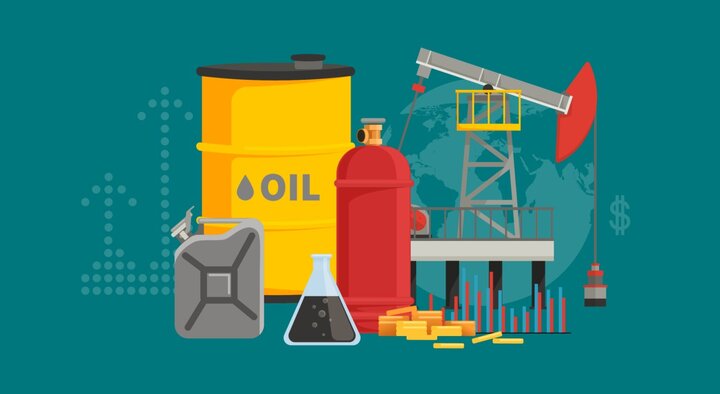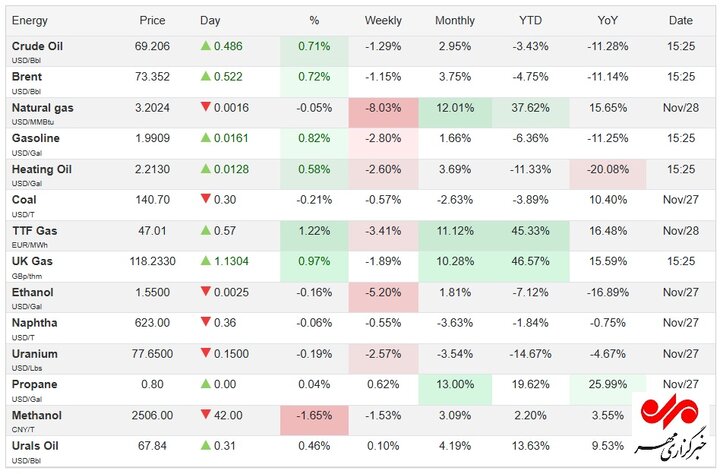The global price of commodities in the oil and energy sector; Thursday, December 8, 1403

reported by Mehr reporter quoted Trading Economics, crude oil price Brent on Thursday while It has increased above 73 dollars ($73 and 34 cents) per barrel, which focused investors’ attention on the upcoming OPEC+ meeting.
Data from the Energy Agency showed that gasoline inventories rose by 3.3 million barrels last week, significantly higher than the expected increase of 200,000 barrels. However, US crude oil reserves decreased by 1.8 million barrels, which was more than the expected decrease of 1.1 million barrels.
Markets are closely watching Sunday’s OPEC+ meeting on speculation that the group may delay a planned January output hike amid signs of tight supply and weak demand growth. To postpone the fuel from the main consumers.
On the other hand, traders continue to evaluate geopolitical developments in West Asia, as the recent ceasefire agreement between the Zionist regime and Lebanon’s Hezbollah has reduced some risks, although the uncertainty after The harsh statements of the Prime Minister of the occupying Quds regime continue, while the new unrest in Syria has fueled concerns.
Accordingly, the price of WTI crude oil increased by 47 cents to 69 dollars and 20 cents per barrel on Thursday.
On the other hand, US natural gas futures fell more than 7% to $3.20 per MMBtu (million British metric thermal units). The latest report from the EIA showed that utilities pulled 3 billion cubic feet of natural gas from storage in the week ended Nov. 22, roughly in line with market expectations.
While that was well below the average of 5 It was 30 billion cubic feet per week.
US gasoline futures fell to a weekly low of $1.96 a gallon after data showed a significant increase in gasoline inventories. Inventories increased by 3.3 million barrels to 212.2 million barrels last week. This increase in reserves added additional pressure to the gasoline market, which is already weakened by the impact of the drop in oil prices. The oil market reacted to the cease-fire agreement between the occupation regime and Hezbollah of Lebanon, which was implemented on Wednesday. Attention is now focused on Sunday’s OPEC+ meeting, where members are reported to be considering delaying a planned production increase to address oversupply concerns.
U.S. heating oil futures fell below $2.20 a gallon to a two-week low as the dollar weakened and natural gas prices fell. A weaker dollar has made oil and other dollar-denominated goods more affordable for foreign buyers, boosting exports but also contributing to temporary domestic oversupply, which has pushed prices down. Meanwhile, the steep drop in natural gas prices has intensified competition in the residential heating market, prompting consumers to seek cost-effective alternatives. In addition, abundant global oil supply, lingering concerns about slowing economic growth from China and anticipation of possible US tariffs on Canadian and Mexican oil imports have further pressured oil prices.
Newcastle coal futures were below $142 a tonne in November, close to their lowest level in late 2018, on the back of abundant supply from China and greater access to competing energy sources. September remained. China’s coal output rose 4.6 percent in October from a year earlier as the end of safety inspections at major mines allowed producers to increase capacity, the latest data showed. In addition, heavy rains in the Yunnan region of this country increased the production of hydroelectric energy and took a larger share of electricity production. However, strong demand for coal power this year has kept futures prices up 25 percent from this year’s low in March. China’s thermal power output rose nearly 10 percent year-on-year in September, despite growing concerns about the country’s macroeconomic woes. More demand was emphasized with a 13% increase in imports during this period to a record high of 47.6 tons.
The European natural gas future price fell to the lowest price in the week (46 euros per megawatt hour) due to warming weather and increased wind energy production and reduced demand for gas. Average temperatures in northwest Europe are around 2C above normal for the season, while strong LNG supplies from French terminals pushed prices down. However, US sanctions on the Gazprom bank have complicated European payments, and a transit agreement between Russia and Ukraine expires at the end of the year. Gazprom reportedly does not expect any gas to flow through Ukraine after December 31, reflecting Ukraine’s long-standing refusal to renew the contract. .
UK natural gas futures prices drop to 115.8 pence per term (100 cubic feet of natural gas CCF) It found, which mirrored the European index, as warmer weather and more powerful wind power production reduced demand.
Ethanol has decreased by 12 cents per gallon (7.12 percent) since the beginning of 2024. In June 2006, ethanol reached the highest level of $4.33
NAFTA has decreased by 11 dollars and 65 US cents (equivalent to 1.84%) since the beginning of 2024. This is while historically, NAFTA had reached its highest level of $1,180 and 47 cents in July 2008.
Uranium price also fell below 78 dollars per pound, which is close to the lowest price in a year (about 77 dollars on November 8) and at the speed of a short-term rally. which increased the price of uranium to 82 dollars.
While the market participants are studying the impact of Russia’s export restrictions on nuclear fuel, Moscow will sell enriched uranium to the United States in response to Washington’s decision to ban Russian nuclear fuel imports. prohibited, although the limits of both sides are flexible.
According to the latest data, Russia is responsible for almost half of the world’s uranium enrichment capacity. It should be noted that a large part of European power companies have voluntarily refused to supply Russian uranium after the start of the war in 2022. On the demand front, low wind in Germany (the world’s third largest producer of wind power) and expensive natural gas in Europe have boosted France’s nuclear power generation to its highest level since 2015.
Per gallon of propane has increased by $0.13 (13 cents), or 19.62%, since the beginning of 2024, and historically, propane reached its highest level in February 2014. It means 1.67 dollars.
Methanol price has increased by 96 yuan per ton (CNY/T) or 3.92% since the beginning of 2024, historically, methanol in October 2021 to It had reached its highest level of 4278 yuan per ton.



